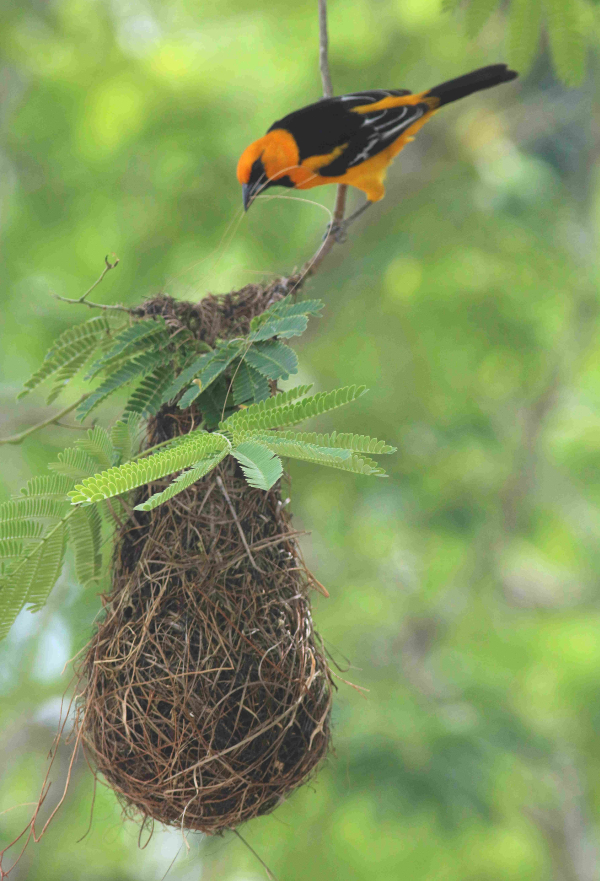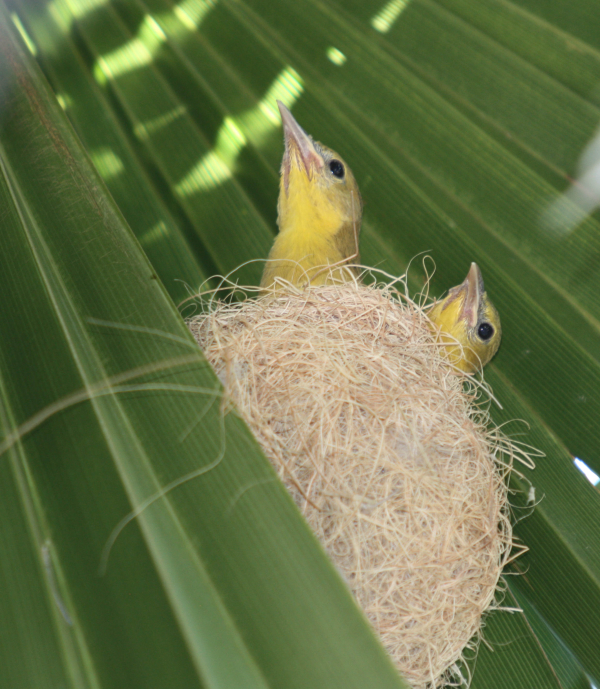
An Altamira Oriole weaving a nest, which tends to be even longer than the nests of other oriole species (photos by Paul Konrad).

A Hooded Oriole nest woven under a palm frond filled is with nestlings that will fledge soon. Female Hooded Orioles often use “strings” stripped from palm fronds to build their nest, as was done with the material of this nest.
|
As we delight in the orioles visiting our feeding stations and adding lively color to our yards and neighborhoods, consider the next step in their annual cycle – nesting! Orioles are famous for their nest-building prowess, and Baltimore Orioles, Bullock’s Orioles, and Altamira Orioles may build the most impressive nests of all American songbirds. Suspended like a woven hanging basket from a tall down-hanging branch, these orioles’ nests stand out from other North American birds’ nests. With hundreds of thin intertwined fibers, these hanging nests are built to hold up to 7 eggs and last for months beyond their intended purpose; a testament to the skill and efforts of orioles.
“It’s absolutely fascinating to sit and watch them weave,” explained Nancy Flood, a Thompson Rivers University biologist who has studied orioles for 40 years. “You see the female poking one end of the plant material through, then pulling her head back to weave it out, like when you crochet or knit a bag. They can spend half an hour doing that, then fly away to get another long piece of grass and do more.”
A group of more than 20 species, New World orioles are often recognized by their vibrant orange or yellow plumage with black accents. Their nesting seasons extend from May to July, though their nests can usually be seen well into fall and some survive into winter. Male orioles might assist in the gathering of materials, but the craft of weaving the pouch-like nests is usually completed by the females.
Most oriole nests can be found hanging in the canopy of a deciduous tree, quite secure from predators, but some species that nest in the Great Plains, notably Orchard Orioles, build bowl-shaped nests in low shrubs to shield them from the wind. Hooded Orioles and Scott’s Orioles will build their nests attached to the underside of palm fronds or yucca leaves in the American Southwest and northern Mexico.
Nest materials vary as well; females choose fitting material that is immediately available around the nest site. Baltimore Orioles like to snap up the fluff that falls from cottonwood trees, whereas some Scott’s Orioles pull pieces from Joshua trees in which they nest.
The weaving process requires patience and experience. First the bird winds long fibers around a branch to create the support strands for the rest of the structure. Then, the female makes a series of rapid thrust-and-draw movements with its beak to begin forming the pouch. She uses more flexible fibers to create an outer bowl before switching to springier fibers for the inner bowl. Downy fibers are added inside to complete the nest and provide a soft lining to cushion the eggs. Construction can take between 1 to 2 weeks, but the complex process results in a durable structure (in one study 85 percent of nests were still in place after a year). The birds don’t typically reuse nests, but they might take material from old nests to build a new one.
Experts aren’t sure why orioles and other birds have adapted to build hanging nests. The most obvious benefit is that the deep cups and narrow entrances – 2 to 3 inches wide – provide better protection from predators and brood parasites. Oriole species with more concealed nests – including Baltimore, Orchard, Scott’s, and Hooded Orioles – tend to have shallower pouches, typically ranging 3 to 4 inches in length. By contrast, Altamira Orioles have much deeper nests. Flood says she’s seen 18-inch-long Altamira nests hanging in Mexico. In this case, noting that their depth affords them much-needed protection from cowbirds (potential brood parasites) and crows (potential predators).
Ultimately, an oriole’s ability to create these architectural wonders is driven by instinct, not creativity. Through evolution the birds have become increasingly adept at weaving hanging structures that increase the chances of their offspring surviving. If a nest breaks, there will be no nestlings to carry on the poor nest builder’s genes, Flood explained; adding that even though the oriole’s nest-building ability is instinctual, it takes time and experience to perfect it.
This article by Kristine Liao originally appeared in Audubon and can be referenced at https://www.audubon.org/news/how-orioles-build-those-incredible-hanging-nests